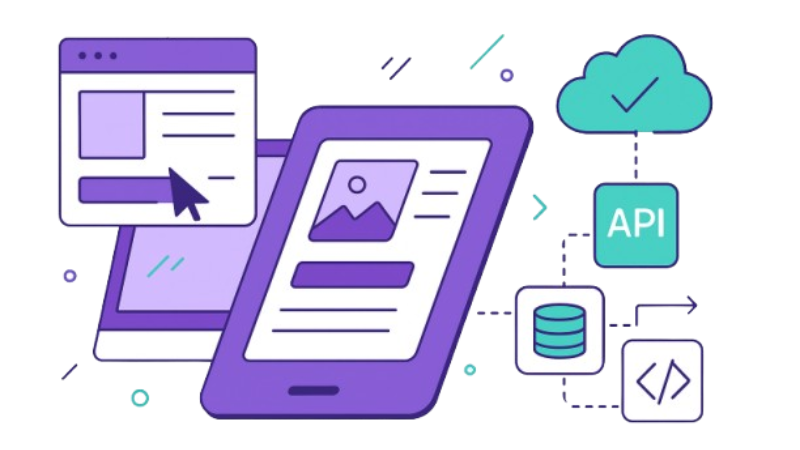WeWeb
What is WeWeb?
WeWeb is a front-end no-code builder that allows you to create high-performance, fully customized websites and web applications—without writing code. Unlike basic website builders, WeWeb gives you pixel-perfect design freedom while connecting seamlessly to external APIs, backends, and databases.
With WeWeb, you can design your site visually and still achieve the flexibility of custom code. It’s fast, responsive, and built for businesses that want professional-grade applications without relying on heavy development resources.

Main features of WeWeb:
The Publisher
WeWeb includes a powerful visual editor where you can design with drag-and-drop components or dive into custom HTML and CSS if needed. The platform supports version history, collaborative editing, and reusable components.
You can easily adjust layouts for different devices, ensuring a fully responsive experience across desktop, tablet, and mobile. Built-in style guides keep branding consistent, while the workflow system allows you to automate actions, triggers, and logic for complex projects.

Integrations with popular platforms
WeWeb connects with external tools through REST, SOAP, and GraphQL APIs, making integrations simple. From Airtable and Supabase to Postgres and Google Sheets, you can bind your front-end to any backend service. This flexibility makes it possible to design rich user experiences without worrying about data handling complexity.
APIs & Data Sources
WeWeb allows you to pull in and display data from multiple sources. You can fetch live updates via APIs, connect databases for structured content, and use authentication layers like OAuth2 and JWT to secure your applications.
For advanced cases, you can mix front-end logic with backend workflows, creating powerful, dynamic web apps without touching JavaScript.
WeWeb Use Cases:
WeWeb can power a wide range of business and personal applications, including:
- E-commerce: Build online stores with shopping carts, checkout flows, and order tracking.
- Content & Blogs: Launch SEO-friendly blogs with dynamic CMS content.
- Learning Management Systems (LMS): Create educational portals with courses, lessons, and student dashboards.
- Customer Relationship Management (CRM): Manage customers, track leads, and automate interactions.
- Dashboards & Internal Tools: Build admin panels, analytics dashboards, and company intranets.
Pricing Web
WeWeb offers multiple plans to suit different needs:
- Starter – For testing and small projects
- Pro – For freelancers or growing businesses
- Team Plans – For collaborative projects with multiple users
- Enterprise – For large-scale companies requiring custom features, dedicated support, and advanced integrations
Pricing is flexible and scales with your business, so you only pay for what you need.
Advantages of WeWeb
- Visual design freedom with full customization
- Connects to any backend or database
- Responsive layouts across all screen sizes
- No need for external plugins
- Strong scalability for business-grade apps
- Open-source friendly with the ability to add custom code
Comparison with other no-code website building platforms
Compared to traditional builders like WordPress or Wix, WeWeb offers more flexibility for developers and designers who want custom designs with database-driven backends.
Compared to Bubble, WeWeb provides a stronger front-end focus, making it ideal for teams that want high-quality UI with backend freedom. Bubble, on the other hand, is often better suited for those looking for deeper backend automation in one tool.
Conclusion
WeWeb stands out as a no-code platform that balances design freedom with backend flexibility. It’s perfect for businesses, startups, and creators who want to launch modern, responsive, and scalable applications quickly. Whether you’re building an e-commerce store, a customer portal, or an enterprise dashboard, WeWeb gives you the tools to create without compromise.
The No Code tools we use
Let's talk about your application, AI agent or automation.
Frequently asked questions about
We help you build businesses that are human, sustainable and much more efficient.
WeWeb goes beyond basic site builders like Wix or Squarespace it’s a front-end no-code platform that gives you full design control while connecting directly to your own APIs, databases, and backends.
No. You can build everything visually using drag-and-drop components, though you can add custom HTML, CSS, or JavaScript for extra flexibility if needed.
Yes. WeWeb integrates with REST, SOAP, GraphQL APIs, and popular tools like Airtable, Supabase, Postgres, and Google Sheets.
WeWeb is built for both. You can design websites, dashboards, CRMs, e-commerce stores, and learning platforms with dynamic data and logic-based workflows.
Absolutely. Every design is fully responsive by default and can be adjusted for desktop, tablet, and mobile within the visual editor.



